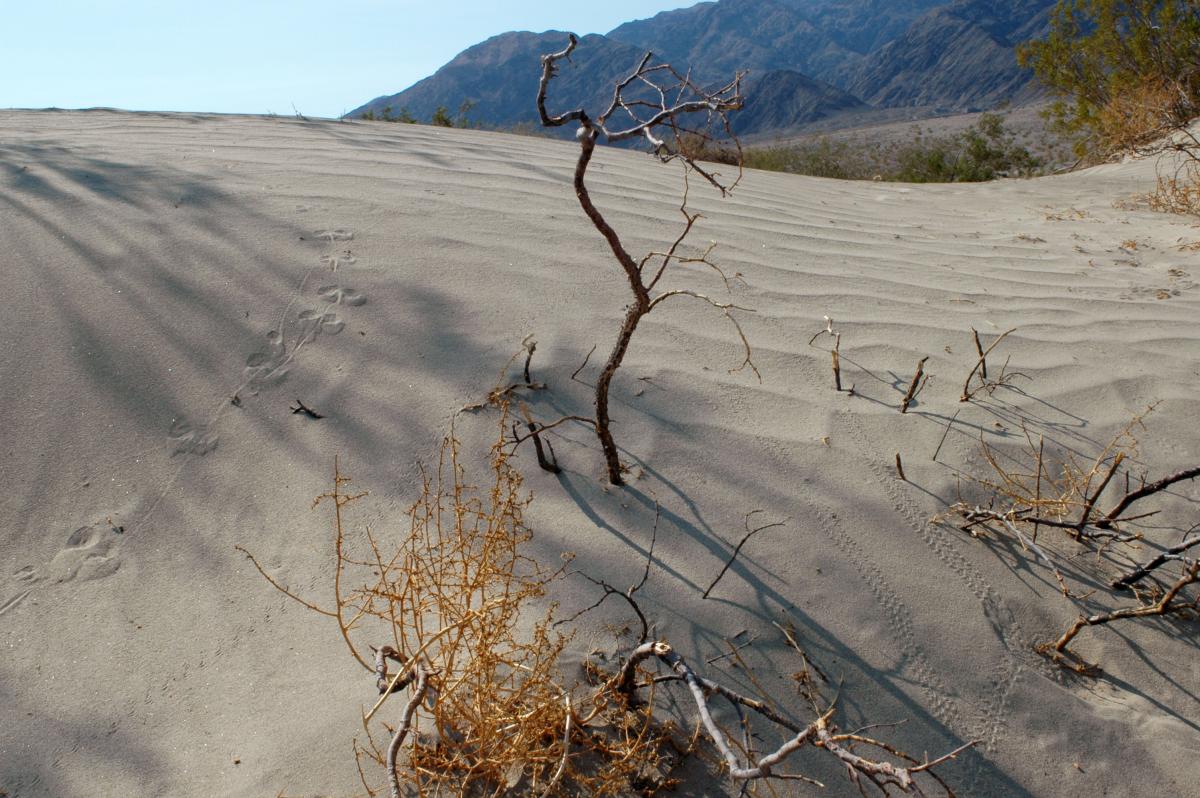Sand Dune Systems

Sand dune systems are microcenters for biodiversity (Figure 1).1 The dynamic nature of sand dune systems forces evolution of unique adaptations that allow species to survive in sand dune habitat; thus, dune species are ill adapted for survival outside of dune habitat.2 For example, psammophiles (plants restricted to active sand dunes) produce large seeds with larger food reserves than non-psammophiles, allowing psammophile seedlings to emerge even when deeply buried by sand.3 However, the production of large seeds restricts the number of seeds that a plant can produce, making it more difficult for large-seeded psammophiles to compete in non-dune habitat where the production of smaller, more numerous seeds may be advantageous. Cameron Barrows, a researcher for the Desert Studies Initiative, notes:
“Sand dunes are incredibly difficult places to live if you’re a plant or an animal because the surface of the sand is constantly moving, almost on a daily basis – certainly on a weekly basis...[Plants and animals] have to be able to deal with a high level of dynamics. All of the adaptations that enable them to do that don’t function at all off of the sand dunes, so they are less competitive when they get off the sand dunes. As a result, most of the species that evolve on sand dunes are unable to move very far distances in between sand dunes.”
The evolution of unique dune adaptations is evident in the array of dune-endemic or dune-restricted species, such as the flat-tailed horned lizard (Phrynosoma mcallii), desert kangaroo rat (Dipodomys deserti), Peirson’s milk-vetch (Astragalus magdalenae var. peirsonii), and Hardy’s dune beetle (Anomala hardyorum). These species and many others are dependent on wind to transport sediment to and from these habitats. The loss of these transport processes could result in the loss of dune endemic species and the habitat on which they depend, as well as jeopardize the continued existence of critical habitat for threatened and endangered species, such as the Coachella Valley fringe-toed lizard (Uma inornata).4
One of the greatest threats to the persistence of sand dune systems is the interruption of the sand transport processes. Because sand dune systems rely on sources of sediment and wind to transport sediment, interrupting either of those processes can alter the balance between sediment deposition to the dunes and sediment transport away from the dunes. Sand transport processes can be interrupted by housing development, wind breaks, and other structures that prevent sediment deposition or create barriers to natural wind movement.5,6 Modification of water channels can also interrupt wind processes. One study found that modification of river channels within the Coachella Valley reduced the amount of sediment deposited in the valley during flood events, which reduced the amount of sediment available
for transport by winds to replenish dune sediments.7 The reduction in deposited sediment resulted in stabilization of the major active dune habitat in the Coachella Valley.8
1 Cameron Barrows, Assistant Research Ecologist, University of California, Riverside Center for Conservation Biology, Personal Communication, November 3, 2009.
2 Cameron Barrows, Assistant Research Ecologist, University of California, Riverside Center for Conservation Biology, Personal Communication, November 3, 2009.
3 J.E. Bowers, “Seedling emergence on Sonoran Desert dunes,” Journal of Arid Environments 33 (1994): 63-72.
4 C.W. Barrows, K.L. Preston, J.T. Rotenberry, M.F. Allen, “Using occurrence records to model historic distributions and estimate habitat losses for two psammophilic lizards,” Biological Conservation 141 (2008): 1885-1893.
5 C.W. Barrows, “An Ecological Model for the Protection of a Dune Ecosystem,” Conservation Biology 10, no. 3 (1996): 888-891.
6 C.W. Barrows, K.L. Preston, J.T. Rotenberry, M.F. Allen, “Using occurrence records to model historic distributions and estimate habitat losses for two psammophilic lizards,” Biological Conservation 141 (2008): 1885-1893.
7 I. Katra, S. Scheidt, and N. Lancaster, “Changes in active eolian sand at northern Coachella Valley, California,” Geomorphology 105 (2009): 277-290.
8 I. Katra, S. Scheidt, and N. Lancaster, “Changes in active eolian sand at northern Coachella Valley, California,” Geomorphology 105 (2009): 277-290.
